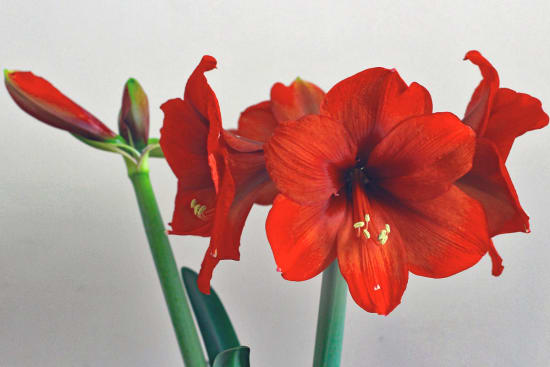Amaryllis
Amaryllis? The Advent flower, popular for its spectacular variety of colours, actually has a different name. But you know why it's a compliment when you get one?

Pssst … the amaryllis is living under a false name.
What we call the amaryllis is as much part of Christmas as the Star of Bethlehem. But this isn't actually the name of the magnificent flower with the huge blossom – it is really called the hippeastrum.
However, it does belong to the amaryllis family, which is probably the reason why it is known by flower aficionados and even professionals simply as amaryllis.

The flower was given the name hippeastrum (which means knight's star in Greek) by the British botanist and cleric William Herbert in 1837.
No one is entirely sure why he chose this name. However, because Herbert was also an expert in mediaeval history, it is thought that the view from above when the red flower opened may have reminded
him of the cross of the Knights Templar.
While we're on the subject of the amaryllis: it originally comes from the savannahs and forests of Brazil, Ecuador, Peru and Mexico.
From there, it came to Europe and is now also grown in Switzerland.

It's gorgeous thanks to modern breeding
The amaryllis will soon delight us once more with its large, funnel-shaped blooms. It offers a great diversity of colours, not only in its natural forms but especially in the cultivars produced by modern breeding.
They range from white, salmon pink and various shades of pink, red and Bordeaux to aubergine.
Bicoloured amaryllises are also available, and even varieties of a delicate, pale yellow are known.
As natural forms of the plant normally only produce two fairly small blooms per shaft, they were cross-bred from the 18th century onwards.
This not only influenced the size of the flower, but also the colours and shapes of the bloom.

The first person who dared to cross-breed the amaryllis was the English watchmaker Arthur Johnson. He crossed Hippeastrum reginae with Hippeastrum vittatum to obtain a hybrid that was later christened Hippeastrum x Johnsonii in his honour.
New hybrids then followed from South America and the Netherlands with more and larger flowers and attracted a great deal of interest.
Hippeastrum breeding ultimately reached the hey-day of its development in the late 19th and early 20th centuries, particularly in Texas, California and Florida.
Two great Dutch breeders moved to South Africa in 1946. Since then, most cultivars stem from Dutch and South African sources.
Nel 1946 due importanti coltivatori olandesi emigrarono in Sud Africa e a partire da quel momento la maggior parte delle varietà proviene da coltivazioni olandesi e sudafricane.

What does it mean when you get an amaryllis?
The language of flowers has mainly to do with the flower itself: its appearance, its care requirements. With the amaryllis, this is clear: it grows beautifully, is elegant and not quite easy to care for. Translated to the language of flowers, this means that the amaryllis is given to someone who is as graceful and distinctive as the amaryllis and who has certain demands.
To get an Amaryllis is therefore a compliment. All the more so, because this wonderful plant also stands for friendship and affection.
It is especially welcome during the Advent and Christmas season, because with its splendid flowers in red, white or soft powder shades it
unfolds festive magic like no other flower and is the most beautiful recipe against the winter blues.
For care tips for amaryllis (plants) click HERE.
For care tips for amaryllis (cut flowers) click HERE.
More exciting topics on flowers & plants
Dahlias
Varied, colorful and simply wonderful: dahlias are an ode to summer and autumn and a symbol of happiness, health and love.
Chrysanthemums
A favourite flower of the Japanese emperor, chrysanthemum has conquered the whole world. Today, the flower with poetic names has countless fans.
Poinsettias
Did you know that poinsettias speak Spanish, that there is a Poinsettia Day and that you have the choice between an unbelievable number of colors and shapes? Find out more.
Christmas-roses
The Christmas roses available from Advent are touchingly lovely. They beautify the outside area despite frost and snow and bloom the whole winter.
Amaryllis
Amaryllis? The Advent flower, popular for its spectacular variety of colours, actually has a different name. But you know why it's a compliment when you get one?
Succulente & cacti
Because they are able to store water, they are particularly easy to care for. But they can also be extravagant, fragrant, flowering and inspire with exotic shapes.
Foliage plants
They're hip. There are many scientific reasons for that. But actually, they're just cool, and healthy, and anything but boring. Here's a little hit parade.








